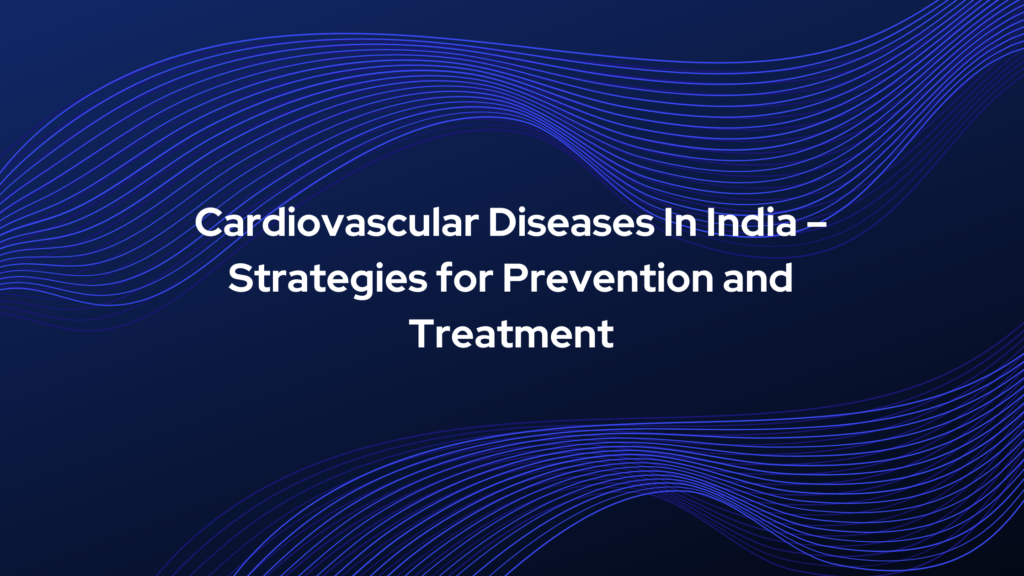Table of Contents
Introduction:
Cardiovascular Diseases In India
Cardiovascular diseases in India are increasing due to increase in prevalence of CVDs and CVD risk factors. Reducing the risk factors is the strategy adopted to prevent and treat CVDs and not the underlying cause. Unless the underlying cause of CVD is targeted it seems difficult to prevent cardiovascular diseases in India like coronary heart disease and stroke.
Cardiovascular diseases (CVDs) became the leading cause of mortality in India.
This epidemiological transition is largely because of the increase in the prevalence of CVDs and CVD risk factors in India.
In 2016, the estimated prevalence of cardiovascular diseases in India was estimated to be 54.5 million.
One in 4 deaths in India are now because of CVDs with ischemic heart disease and stroke responsible for >80% of this burden.
These diseases tend to affect patients in the most productive years of their lives and result in catastrophic social and economic consequences.
Burden of CVD risk factors:
There are several risk factors for rise of cardiovascular diseases in India. These cardiovascular disease risk factors are mentioned below.
Smoking:
Deaths due to smoking:
It is estimated that, currently, 275 million individuals aged >_15 years consume tobacco in India. The monthly burden attributed to tobacco in India is huge, because it is estimated to cause nearly 1 million deaths annually.
Consumption of fruits and vegetables:
Indians are mainly vegetarian. It is expected that they may be eating plenty of vegetables and fruits. On the contrary the survey shows that the rate of consumption of vegetables and fruits is low.
This is due to the high cost of fruits and vegetables. In addition, the vegetables that are consumed are often overcooked in Indian meals. This leads to vital loss of nutrients.
Fat and carbohydrate Intake:
According to one survey, Indians’ fat intake increased from 24 to 36 g/d and from 36 to 50 g/d in rural and urban individuals, respectively.
The consumption of whole grain decreased and the consumption of refined grain products increased.
Physical activity:
Data on physical activity in India are sparse. We can say that physical inactivity is more in India.
Hypertension:
The prevalence of hypertension in adult Indians is estimated to be 30% (34% in urban areas and 28% in rural areas.).
The number of people with hypertension is expected to double from 118 million in 2000 to 2135 million by 2025.
Diabetes:
India is the considered as the diabetic capital. It is estimated that the number of individuals with diabetes mellitus will increase to an alarming 101 million by 2030.
Cholesterol:
Serial epidemiological studies in India suggest a rapid increase in the mean levels of total cholesterol, low-density lipoprotein cholesterol (LDL), non-high-density lipoprotein cholesterol, and triglycerides. In the ICMR-INDIAB study, a large proportion of people had at least 1 lipid abnormality. Only 20% had all lipid abnormality (TC, LDL, HDL & TG) within the normal range. The most commonly observed abnormality was low HDL levels.
CVD In India: Prevention and Treatment Strategies:
Having discussed the burden of CVD risk factors let us see what strategies have been adopted to prevent and treat cardiovascular diseases in India. These policies are based on the suggestions made by WHO.
Actually strategies adopted in the western world have been adopted to combat the epidemic in India.
The strategies adopted should have been on the underlying cause of heart diseases. The strategies adopted are based on reducing mortality by “reducing the risk factors”. For example, if tobacco use is reduced by a certain percentage, the number of deaths due to tobacco use will be reduced to a certain extent. Similar is the case for other risk factors
To the best of our knowledge, there are no data evaluating macroeconomic policy and non-personal interventions on CVD in India. However, modeling studies suggest that substantial benefits could be gained by imposing taxes on tobacco, palm oil, and sugar-sweetened beverages in India.
Obesity and Diabetes: Impose tax on sugary beverages. It is estimated that a 20% tax on sugar-sweetened beverages would reduce overweight and obesity prevalence by 3% and the incidence of diabetes mellitus by 2%.
CVD deaths by raising tax on palm oil purchase: Similarly, a 20% tax on palm oil purchases is expected to avert ~363,000 deaths (a1.3% absolute reduction in CVD deaths) from myocardial infractions(MIs) and strokes over a period of 10 years.
Reducing CVD deaths by reduction in salt intake: Nearly 400,000 events (MIs and stroke) and 81,000 deaths (a5% reduction) can be averted by moderate reduction in salt intake (reducing intake by 3 g/d, over a 30-yearperiod) among middle-aged Indians.
Smoking:Finally, smoke-free legislation and tobacco taxation together may avert 25% of MIs and strokes in India.
Action taken by Govt. of India:
Government of India has raised the excise duty of tobacco products in 2014 up to 72% and levied a new 5% tax on sugar-sweetened beverages. The moves taken are commendable.

